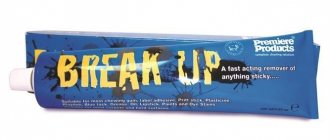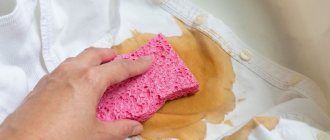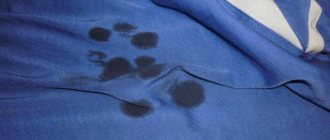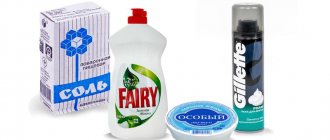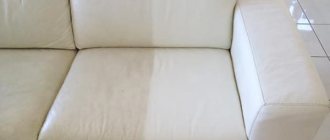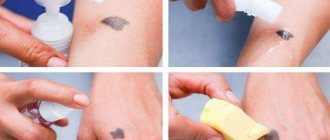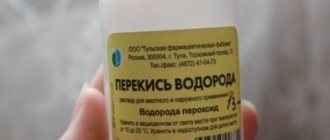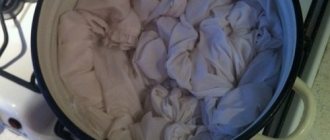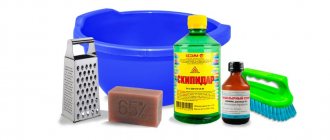Who doesn't love oranges? Unless they have allergies, and, in general, their position is understandable. However, everyone else has no obvious reason to dislike these citrus fruits. Juicy, sweet and healthy too! How can you not love this?
However, there is another category of people who are very wary of oranges. These are business women. They know firsthand how difficult it is to remove orange juice stains from clothes, tablecloths or carpets.
But should we give up our favorite treat now? Not at all necessary! You can simply learn how to effectively get rid of orange stains.
First actions
If your clothes get splashed with orange juice, don't panic. If you quickly and accurately treat a fresh stain, there is a high chance of removing it without a trace. This will help you:
- cold water;
- salt;
- talc;
- glycerol;
- vinegar;
- boiling water;
- lemon acid.
Cold water jet
The most affordable and budget option for removing an orange stain is a stream of cold water. Place the contaminated area under it and wait 15 minutes. The liquid will wash away the bulk of the juice, preventing it from attaching to the fabric, and the final step will be regular machine washing.
Salt
Salt, used as a seasoning in the kitchen, is great for removing orange stains. It's all about the ability of salt to actively absorb excess moisture. It will draw all the juice onto itself, preventing it from penetrating into the tissue structure. It is enough to sprinkle fresh dirt generously and wait 25 minutes. To consolidate the effect, hand or machine wash is suitable.
Talc or flour
Talc or flour has a similar effect to salt. Particles of the substance draw the liquid towards themselves, preventing them from firmly attaching to clothing. Of course, talc is not always within walking distance, but flour is available in almost every kitchen and there shouldn’t be any problems. Treat the stain with any available product, and then simply wash the item.
See also
Rules and review of the best means to remove apricot from clothes
Glycerol
Glycerin works well on fresh orange stains. The algorithm of actions is as follows:
- treat the stain with glycerin;
- we give it some time to interact with the pollution;
- rinse the fabric thoroughly;
- We put the item in the washing machine.
Cool boiling water
Treating the stain with boiling water is considered an extremely effective remedy. It breaks down the bonds between fabric fibers and organic compounds, quickly washing them out of clothes. Only the area contaminated with orange juice should be treated with boiling water, after which the item is sent for washing.
Note! The method is not suitable for all fabrics. Before using it, read the manufacturer's recommendations indicated on the label.
Vinegar
Vinegar is actively used by housewives to remove stains from citrus fruits, having proven itself as an effective and reliable remedy. Simply moisten the orange stain with vinegar and then rinse the fabric with plenty of cold tap water.
Lemon acid
Unlike vinegar, citric acid is not as effective and is only suitable for fresh orange marks. Old stains that have managed to penetrate the fabric fibers properly will be extremely difficult to remove with citric acid.
The algorithm of actions is similar to using homemade vinegar:
- treat the stain with citric acid;
- give some time for interaction;
- rinse the item;
- send it to the wash.
Basic recommendations
You can find out how to remove orange stains on any website; before using the products, you should remember the basic rules:
- Any untested product or solution from improvised means is first checked.
A small amount is applied to an inconspicuous area of the product and left for 10-20 minutes. After time, the fabric is checked for strength and color fastness; if there are no changes, the product can be safely used to remove the orange stain. - It is not advisable to use chlorine-containing products; they can damage the product forever.
- Modern soap with stain remover will also be of little help; orange juice stains will only become more deeply embedded in the fibers after treatment with this product.
- Having chosen the right substance, it is worth remembering that all contaminants are removed only from the wrong side.
- Any product is applied from the edges to the center, this way streaks are avoided.
- After successfully removing marks from clothing, be sure to consolidate the achievements by general washing of the product.
It is worth remembering that fresh stains from citrus fruits, like other stains, are easier to remove immediately and not allow them to dry out.
How to remove old stains
In advanced situations, when the stain has had time to dry thoroughly, the above methods will help little or will not have any visible effect at all.
The following will help in the fight against old stains:
- stain removers, which can be purchased at any household chemicals department;
- steam;
- dishwashing liquid mixed with baking soda.
Stain removers
Special household chemicals, the main purpose of which is to remove difficult stains from the surface of the fabric. They differ in:
- price;
- functionality;
- quality.
There are budget products that can cope with a limited number of contaminants, and there are universal products suitable for almost any situation. Among the popular brands of bleaches that have the largest number of positive reviews among housewives are:
- Antipyatin;
- Ecover;
- Vanish;
- Sarma Active;
- Frau Schmidt.
See also
How and with what you can erase a pencil without an eraser from wallpaper
Sarma Active
A stain remover designed to enhance the cleaning properties of the powder. Among the positive properties of the product are:
- Effective effect on stains when washed at temperatures of 30°C or higher.
- Suitable for washing white and colored fabrics.
- The bleach does not contain chlorine.
- Keeps the fabric looking fresh even after numerous washes.
- Has an antibacterial effect.
The reasonable price adds even more attractiveness to the product.
Frau Schmidt
A German detergent that allows you to maintain cleanliness and order in your home at the highest level. Housewives who use this brand on a regular basis note the following advantages of bleach:
- does not have an unpleasant odor;
- copes equally well with stains on white and colored fabrics;
- does not irritate hands during contact, which is especially appreciated by people with sensitive, delicate skin;
- Excellent value for money and quality.
Vanish
It is considered a leader in the Russian detergent market due to the following competitive advantages:
- Vanish bleach needs 30 seconds to remove most types of stains;
- the product not only removes stains, but also makes the fabric crystal white;
- does not contain chlorine;
- universal to use.
Ecover
A quality bleach used to remove stains from white fabrics. Manufacturers position the product as an environmentally friendly product that does not harm the environment. He copes well with the assigned tasks, fully fulfilling the amount requested for him.
Antipyatin
A domestic product that is in demand both among the local population and abroad. This effect is achieved thanks to:
- hypoallergenic. According to the manufacturers, the product can be used to wash any clothes, including children's items;
- pleasant smell;
- low price. Costs 3 times less than any other “competitor” on the market;
- efficiency.
Steam
If you have a steam cleaner, orange stains can be removed without household chemicals. A powerful jet of hot steam will quickly remove stains from any type of fabric, leaving no traces of contamination. Steam cleaners are convenient to use not only for cleaning clothes; they can also be used on furniture and carpets.
Soda and dishwashing liquid
Baking soda, in combination with dishwashing liquid, shows excellent results that can compete with bleach and steam cleaner. To use the method you must:
- Mix soda with detergent in such a proportion that you get a liquid slurry similar in consistency to sour cream.
- Apply the paste to the contaminated area and give it some time to interact with the orange juice. 25-30 minutes is enough.
- Remove the paste and rinse with plenty of warm water.
See also
15 best ways to remove watermelon stains from clothes at home
Cleaning the sofa from blood stains
Removing blood from a sofa is much more difficult than cleaning it from wardrobe items. The upholstery cannot be removed and washed. But it is possible to deal with bloody stains on furniture.
Universal soap solution
This method will be relevant if the dirt appeared quite recently. It is universal because it is suitable for all types of upholstery. Cleaning steps:
- Fresh drops of blood are blotted with a paper napkin.
- Then wipe off the blood with a small piece of damp cloth, moving from the edges to the center.
- Shavings are prepared from laundry soap and diluted with water.
- The solution is used to treat stains.
- The remaining foam is removed with a clean, damp cotton pad.
Rub the stains with a soap solution until traces of blood disappear.
With fabric upholstery
In order to wash dried blood from the upholstery, you will need aspirin. Moreover, the dose is quite small - one tablet. The drug is crushed and dissolved in a glass of clean water. Using a cloth, the areas are wiped with the prepared solution.
With leather furniture
In this case, the means for removing blood stains is unusual - shaving foam. Due to its delicate action it is used for cleaning natural leather. To remove old stains, you have to additionally use a soft brush.
Shaving foam is applied to areas with blood and left for 25-30 minutes. Remains of the product are removed gradually using a cotton pad soaked in water. Old stains are rubbed with a brush.
You can also clean a leather sofa with another homemade product. To do this, use ammonia and dishwashing detergent. Another effective method is a mixture of lemon juice, water and wine.
Rules for using stain remover
Stain remover is considered an aggressive substance and is not suitable for all types of fabric. Before using it you must:
- read the instructions and make sure that it is allowed to be used for this type of fabric;
- To avoid unpleasant moments, apply the stain remover to an inconspicuous area of the item and wait 5-10 minutes. If nothing happens to the fabric, use the product for its intended purpose.
Note! When using aggressive chemicals, try to protect the skin of your hands from direct contact.
Remedies to help save white clothes
When dealing with stains on white clothes, completely different means are effective:
- First, we simply try to wipe off fruit stains with a cotton pad soaked in a solution of ammonia (part ammonia to part water).
- You can remove pomegranate juice from silk using a weak vinegar solution. To prepare it, dilute part of 10% vinegar in 10 parts of cool water. We treat the stain with the finished composition and send it to the wash.
- Radical cleaning methods include the use of gasoline, white spirit and acetone. The selected product is applied to the stain for 20 minutes, after which the product must be washed. This cleaning option is not suitable for processing wool, silk, velvet and chiffon.
- An old stain will have to be boiled in hydrogen peroxide. It is better not to place the product completely into the solution.
- Before sending the item for washing, a dried stain must be soaked in ethyl alcohol, then the pigments will not linger in the fibers of the fabric.
Neglecting dosages and exposure time can lead to damage to the integrity of the fabric or increased stain resistance. Manipulations must be carried out strictly in accordance with the instructions.
Features of breeding
When removing stains from clothes, it is worth considering some features characteristic of white and colored items. If this is not done, the result may not meet your expectations.
With white clothes
When removing stains from a white T-shirt or other clothing, it is not recommended:
- use substances that contain chlorine;
- use hydrogen peroxide.
Both components can give the fabric an unpleasant yellowish tint, which no housewife will like.
With color
Colored items are easier to process than white ones, but you also need to be careful when working with them. Keep in mind that:
- colored items react poorly to high temperatures;
- colored items can be damaged by strong physical impact.
In addition, some components included in detergents can adversely affect the dyes used on fabrics. This should also be taken into account when choosing a cleaning method.
Traditional methods
In addition to specialized stain removers, you can use traditional methods to remove plum stains. Let's look at several popular and effective methods with which you can easily and quickly eliminate the consequences of interaction between clothing fabrics and berry juice.
Laundry soap and sugar
Laundry soap will help remove a new stain if it has not yet been absorbed into the fabric. There are several ways to clean clothes from dirt using laundry soap. The first method is to thoroughly lather the area of contamination with soap with a concentration of at least 72 percent. Then you need to leave the clothes soaped for twelve hours for the soap to take effect. It is recommended to wrap the soaped part with polyethylene. After the specified time has passed, wash the item using washing powder.
The second method of removing berry stains is distinguished by its speed. It only takes fifteen minutes to remove the dirt. Lather the stain with soap and sprinkle with sugar. Scrub the stained area with a brush. Leave the clothes for fifteen minutes and wash them.
Uses of lemon
Lemon juice can easily remove stains from fabric. However, it is worth remembering that lemon juice acts as a bleach, so this method is more suitable for removing plum stains from white things. Apply a solution of lemon juice and salt to the stain. Leave the item for fifteen minutes, then wash.
Vodka and glycerin
Stains from plum juice can be easily removed from fabric using a solution made from vodka and glycerin. Dilute the ingredients in equal proportions and rub it into the fabric. Then wash the item.
Hydrogen peroxide
Using hydrogen peroxide is an easy and affordable folk way to get rid of plum juice on fabric. There are several ways. The first method is to simply pour hydrogen peroxide onto the stained area of the fabric. Then you need to rub the fabric with your hands and leave for a while until the stain begins to disappear. If necessary, you can add a little more peroxide if the contamination is not removed.
After all manipulations, wash the item with washing powder. There is also the option of hanging the treated item of clothing on the balcony. The scorching sun will enhance the cleansing effect.
You can mix hydrogen peroxide with ammonia and water. We will need one teaspoon of ammonia and peroxide per two hundred milliliters of water. The water should be hot. Soak the item in the solution until the stain disappears from the fabric, then wash. You can also apply a mixture of ammonia and peroxide pointwise to the contaminated area and leave for half an hour, and then wash the item.
With milk
Fruit stains can be removed from clothes using regular cow's milk. Place the soiled item in hot milk for thirty minutes. After half an hour, remove the item and wash it by hand or in the washing machine.
How to remove traces of tangerine juice from walls
If little hands stain the tiled flooring on the wall with tangerine juice, no problem. It can be easily washed off with a cloth soaked in warm water and baking soda. In the same way, stains can be washed off from painted walls, but with wallpaper it’s not so simple.
Washable vinyl wallpaper can be wiped with a soft, slightly damp cloth. But initially do this on an inconspicuous small area. If the wallpaper has not faded or darkened, feel free to use it on dirt.
There aren't many options with paper wallpaper. Before re-pasting expensive wallpaper, try treating the tangerine stain with a porridge of water and flour
Wait until the mixture dries and carefully remove it with a vacuum cleaner.
Before resorting to drastic measures: going to the dry cleaner, replacing furniture, new renovations, try the suggested methods for getting rid of tangerine stains.
https://krasna-devica.ru
Appetizing and tasty tangerine is the most favorite delicacy of almost everyone; The zest of citrus fruits is used to season several dishes, as well as for the preparation of cosmetic masks. The orange fruit has become a common delicacy during the Christmas holidays.
But all gastronomic joys also have a second side to the coin - the so-called random spots. After all, things that are stained with tangerine juice are quite common, especially when children grow up in the home. To remove this kind of contaminants at home, you can use improvised means.
You will need a few things:
- stain remover;
- salt;
- egg yolk;
- glycerol;
- sour milk (suitable: fermented baked milk, kumiss);
- kettle with boiled water.
Instructions
- Salt. As soon as a tangerine stain appears, you must immediately begin to remove it - if the juice from a citrus product penetrates deeply into the texture of the fabric and dries, it will become even more difficult to clean such a product. Place the soiled item in a basin and sprinkle table salt onto the fresh stains. It is advisable to first prepare a paste of water and salt, and then rub it on the affected area. The clothes should sit for more than half an hour, after which they can be washed first in cool water, then washed in a warm solution of soap, preferably laundry soap. Rinse the cleaned item thoroughly.
- Boiling water. Water is poured into the kettle and brought to a boil. The tangerine stain should be splashed with boiling water under a constant stream. Later, you can wash the item by hand or in a washing machine, using any detergent that is suitable for this type of fabric. Remember: cleaning citrus juice in this way is only allowed from a snow-white cloth, or from a very resistant surface.
- Dairy products. Clothes stained with tangerine juice must be dipped in sour milk, kumiss, or fermented baked milk. Thus, housewives can deal with emerging citrus stains by “sourdough” for 5-7 minutes. At the end of this procedure, you need to rub the clothes with laundry soap, then wash them until completely clean.
- Glycerol. On colored clothing, rub glycerin over the tangerine juice stain. To achieve the best results, you can also add the yolk of a chicken egg to this pharmaceutical product. After this, the item must be left to soak for a couple of hours. When time has passed, you need to wash the item as usual.
- Cleaners. Choose a suitable stain remover or oxygen brightener (but only for snow-white things!). Traditionally, special cleaning mixtures work well with tangerine juice.
Follow the instructions indicated on the packaging of this product. If there is still a visible halo at the site of your stain, you should soak the clothes in a small solution of the powder overnight, and wash them again in the morning.
Many of us associate tangerines with New Year's holidays, fun and incredible surprises. However, stains on clothes from them are removed with great difficulty and do not bring joy.
Traces of this juicy fruit can be found not only on children's clothing, but also on carpets, curtains, walls and furniture.
Only at first glance it seems that it is very difficult to remove tangerine stains. Experienced housewives claim that fresh marks can be removed using a mixture of laundry soap and warm water. To remove old stains from clothes, you will need:
- salt;
- kefir;
- glycerol;
- serum;
- baking soda;
- any stain remover;
- bleach (preferably oxygen);
- egg yolk;
- lemon acid;
- hydrogen peroxide;
- baby or laundry soap;
- high quality washing powder.
Having at least half of these ingredients in your arsenal, it is possible to remove stains on white or colored linen.
Home methods
Despite the fact that there are now many chemical products that do the job well, some housewives still use old and proven home methods for purifying orange juice. Pollution can be either old and ingrained or new.
The easiest method we can suggest is to run the fresh stain under cold water. Water washes away stains that were made less than ten minutes ago and is therefore the safest method. The same safe method is table salt, which you need to pour in for a while and wait until the juice is absorbed. After which the item is washed as usual.
Orange stains can be easily removed with boiling water. This method is used, in particular, for white clothes. Boiling water is poured directly onto the problem area until the stain begins to disappear. Once the desired result is obtained, the clothes must be washed in a washing machine or by hand. Quite often, other cleaning options are added to this method, which allow you to achieve the desired result quickly.
If you don't know how to wash an orange, you can use vinegar. But under no circumstances should you use an essence that can ruin the item, especially the colored one. The stain is treated with a cotton pad or small cotton wool. The area is wiped until the stain begins to lighten and disappear. This method must be used carefully so as not to damage the structure of the fabric and not leave vinegar stains.
The faster the better
Citrus fruits are loved by everyone; they are valuable not only for their beneficial properties in the form of vitamin C, but their aroma is associated with the pre-New Year bustle and the expectation of a miracle. But oranges can pose a difficult task for housewives: to wash the nutritious orange juice from clothes.
Time plays an important role in the fight against fruit stains. The sooner you start removing a stain, the greater the chance of getting a clean item as a result of your work. For orange stains, this time ranges within ten minutes from the moment the juice drops hit the product.
Emergency measures to remove orange stains:
- Use a stream of cold water to rinse the stained fabric. In some cases, you will need to initially treat the area of contamination with table vinegar, previously applied to a cosmetic cotton pad. Wine vinegar will not work in this case. After this, it is necessary to treat with cold water.
- Sprinkle the stain with salt or talcum powder, which immediately absorbs most of the liquid and prevents it from penetrating deep into the fibers of the fabric. Then you can wash the item by hand or use a washing machine.
- If white clothes become dirty, it is better to immediately pour boiling water over them and then wash them. This procedure can be used if the fabric is dense enough, not dilapidated, and can withstand such a heavy load.
- For delicate fabrics, glycerin applied to the area of orange stain for up to two hours will help. After the specified time has passed, the product is rinsed in clean water and, using the delicate wash mode, is completely cleaned in the washing machine.
- On clothes made of natural silk and light satin, ethyl alcohol will help get rid of citrus stains. It is heated a little and the area of contamination is wiped with a cotton swab or disk.
If you have the opportunity to immediately work on orange stains and get them out of your clothes, that's great, but things don't always go according to plan. Fortunately, long-standing stains can be treated too. Let's look at how to remove old, dried orange stains.
RESULTS µÐ¹?
RESEARCH, RESEARCH ¾Ð¿ÑобÑйÑе воÑполѷоваÑÑÑÑ ÑÑÑÐ °Ñой-добÑой белизной. ROOM, ROOM, ROOM µÐ³Ð¾ ÑÑиÑалÑнÑм поÑоÑком или Ñоз мÑвеннÑм мÑлом. registry ²Ð°ÑÑ ÑкÑÑÑнÑÑ ÐºÐ¸ÑлоÑÑ (72%) или нР°ÑÑÑалÑнÑй Ñок лимона. RESULTS, ROLLUP.
Lemon acid
Citric acid is an excellent way to eliminate tangerine stains:
1. Dissolve 1 teaspoon of acid in 200 ml of water and apply the mixture to the stain. Wait 15-20 minutes and rinse the item.
2. Use when soaking to achieve a more pronounced result and remove old stains.
Packaged citric acid and fresh lemon juice are suitable.
Soda and dishwashing liquid
The following remedy will help remove citrus stains on a light-colored carpet:
- Take baking soda and dish liquid.
- Mix until the consistency of a thick paste.
- Apply to stain.
- Hold it for a while.
- Wash without powder or soap, just water.
- Before you buy any stain remover, study the composition. The label should indicate which fabric it is suitable for. If you wash colored items, be sure to check the color fastness of the stain remover.
- Apply the product you will use to remove stains to a small and inconspicuous area of fabric. Check the reaction of the product so as not to spoil it even more.
- After removing the stains, wash the item as usual.
- Bleach is used specifically for white fabrics. Before using such a product, find out whether it contains chlorine, as it is not suitable for many types of fabrics.
Citrus fruits - tangerines, oranges and grapefruits - are loved by both adults and children. But the abundance of juice contained in these products cannot but cause concern for experienced housewives. No matter how hard you try not to get dirty when you eat, for example, an orange, there will still be some kind of stain, and it will happen. If an orange falls into the hands of a child, a headache is guaranteed for the parents.
If you immediately notice contamination, try to remove it as quickly as possible before the juice dries.
This will greatly simplify your task. There are several ways to do this that you can use at home:
- Rinse the dirty area of clothing under running cold water. Water will wash away the bulk of the juice and it will be much easier to remove this stain.
- One of the most popular methods of dealing with fresh stains at home is salt. Sprinkle salt on the dirt. It will absorb the juice, which will simplify your task in the future, during washing.
- Sprinkle talcum powder or flour onto the contaminated area and wipe off after a few minutes. If necessary, repeat the procedure again. The effect will be similar to salt - the flour absorbs the juice.
- Glycerin can also be used. Apply it to the contaminated area, after a couple of hours, rinse the product under cold water.
- If the fabric is strong enough, wash the stain under boiling water. This is a rather dangerous method, although effective - so it is better not to try it on new things. Place the contaminated item in a basin and pour boiling water over the area where the stain occurred. Afterwards, wash the item in plain water with powder.
- Soak a cloth or cotton wool in vinegar and press it onto the stain for 5 minutes; after the procedure, rinse the cloth in cold water.
- Add 1 teaspoon of citric acid to 100 milliliters of boiling water and pour the solution onto the stain. After a few minutes, wash in warm water.
